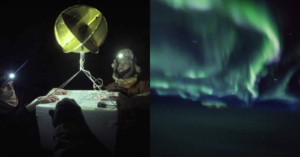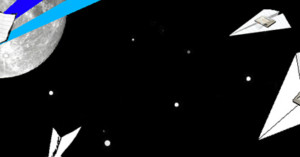
These Epic Photos From Space Were Shot With a Smartphone
Samsung sent four Galaxy S24 Ultra smartphones into space on stratospheric balloons in order to capture literal out-of-this-world photos of the western United States.

Samsung sent four Galaxy S24 Ultra smartphones into space on stratospheric balloons in order to capture literal out-of-this-world photos of the western United States.

After the media storm that followed the official shooting down of an alleged Chinese spy balloon, the United States Air Force downed three other unidentified objects. There is an increasing possibility they were harmless civilian weather balloons.

Colorado-based aerial remote imaging company Urban Sky has announced that it has begun commercial operations to provide full-color imagery from its "microballoon" platform that photographs the Earth from the stratosphere.

To celebrate Earth Day, the team from Hi-Impact L&D attached an Insta360 ONE X2 action camera to a weather balloon and sent it into the sky, allowing it to capture a stunning view of Earth from over 80,000 feet in the air.

The Insta360 team partnered with NewMakeIt to send its tiny ONE X2 action camera high enough into the sky to clearly see the darkness of space and the curvature of the Earth.

Three photographers recently sent a professional full-frame camera, the Sony a7S III, to near space on a weather balloon and managed to capture groundbreaking "close-up" shots of the Aurora Borealis (the "northern lights").

In August of 2017, the team at Sent Into Space travelled to Fort Laramie, Wyoming to capture something incredible for the BBC. Using a high-altitude weather balloon and a 360° camera array, they captured what they claim is "the world's first hyperlapse of an eclipse from the edge of space."

Samsung's 'SpaceSelfie' satellite, which was supposed to stay aloft until October 31st, came crashing to Earth this weekend. The device, which was held aloft at 65,000 feet by a massive high-altitude balloon, had to make a "planned" landing on Saturday, only a day after Samsung announced the launch of the campaign.

Self-proclaimed "armchair aeroscience geek" Liem Bahneman managed to capture the Great American Eclipse from an unusual and amazing perspective: he loaded cameras onto a high-altitude and shot what the total solar eclipse looks like from the edge of space. The 9-minute video above is what one camera recorded over Central Oregon.

The folks at Night Crew Labs just created something awesome. In March, they strapped a Sony a7S and an external recorder to a weather balloon, and launched it up to about 78,000 feet. From there, they captured what they believe to be the "first ever" video of the Aurora Borealis from the stratosphere.

A group of 5 friends recently attached 5 cameras to a stratospheric weather balloon and launched it from the Presidio in San Francisco. The rig traveled to 91,470 above Northern California, popped, and then landed over 100 miles away.
The aerial photos and videos it captured are remarkable, showing sweeping views of San Francisco and the surrounding Bay Area.

Back in 2013, five friends in Arizona decided to capture some photos and video from the edge of space by sending a GoPro up on a weather balloon. The camera made it to 98,000 feet, but the guys lost track of it after it landed out of cell phone tower range. All seemed lost, and the team spent months wondering if they'd ever find the camera.
Fast forward to a couple of months ago: the team got a phone call from a woman who found a strange box with their names on it. In it was the camera and all of the original images.

Earlier this summer I was asked to shoot a campaign for Airwick USA to highlight the many uses for their new color changing candles. It was going to be a summery outdoor shoot involving two distinct ‘looks’ for the images; one with the candles being used at night time, and the other where they were being used during sunset or dusk activities.

Raspberry Pi's new Camera Module is starting to hit store shelves, and we're starting to see some interesting photo experiments being done with the simple programmable camera kit.
High altitude ballooning enthusiast Dave Akerman recently decided to send his $25 module up to the edges of space to snap photographs of Earth and beam images back during its flight.

Hanging a camera from a weather balloon and using it to snap photographs from the edges of space has become quite a popular project for space and photography enthusiasts as of late. If you want to try your hand at it, but don't have the time, energy, creativity, or resources to create the space vessel yourself, NYC-based industrial design company Quirky is working on a product just for you.

Sending a camera up to the edges of space on a weather balloon has been done quite a bit now, but perhaps none of the projects have been as creative as Ron Fugelseth's effort. Ron worked with his 4-year-old son to give his son's favorite toy train Stanley a fun and exciting ride to space. They built a rig consisting of a weather balloon, a styrofoam box, an HD video camera, and an old cell phone for GPS. Stanley was then attached to the outside of the box using a rod, positioned so that the camera would be perpetually pointed at Stanley with the world in the background.

On December 31st, 2011, Oaida Raul decided pay a tribute to the recently-retired …

A couple weeks ago, 17-year-old Canadian teens Mathew Ho and Asad Muhammad successfully sent a Lego man and four cameras to the edges of space on a weather balloon and captured photographs of the figurine posing with a Canadian flag at 78,000 feet -- three times the cruising altitude of jets.

Photographer Edouard Janssens recently sent a weather balloon equipped with a Sony NEX-5 …

Sending cameras to the edges of space on a weather balloon has become a pretty popular activity as of late, but up to now people were mostly sending up cell phones, compact cameras, and small HD video cameras (e.g. GoPros). While those devices are light and relatively cheap, the quality of images produced isn't the best.

Luke Geissbuhler and his kids decided they wanted to send an HD video camera high into the stratosphere, so they spent eight months researching and testing for their project before finally launching their Go Pro Hero HD-laden balloon from Newburgh, New York. The balloon rose for 70 minutes to a height of 100,000 feet (19 miles) above the Earth before popping.

Viral marketing agency The Viral Factory is helping Samsung with an experiment in which they're planning to drop 100 SD cards attached to paper airplanes from 21 miles above the Earth in the stratosphere. Instructions will be printed on the paper airplane informing anyone who finds one of the experiment and what they can do to participate. Finders are encouraged to shoot with the cards and then upload anything taken to the Project Space Planes website.
The claim that the planes will "carry the messages across the world" is a bit farfetched, but supposedly the planes could potentially travel hundreds of miles depending on the wind conditions. The experiment is planned for mid-October.

Pacific Star is a photography project by Colin Rich in which he sends programmed cameras up to epic heights using homemade weather balloons. This is an interesting step-by-step look into what went into the second launch. After purchasing two Canon compact cameras on eBay, Rich programmed them to take 3 photos every 3 minutes, and shoot a minute of video every fourth minute. The cameras were then insulated in styrofoam, and sent up to 125,000 feet before the balloon burst. With the help of a parachute, the cameras descended for 35 minutes and landed about 15-20 miles away.